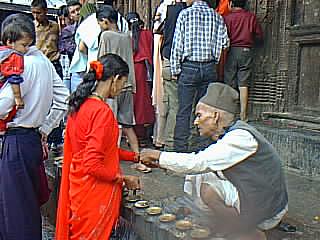



Throughout the Kingdom today, the "Tagadhari" (or those who wear the "Janai" or sacred thread on their bodies) change the "Janai" after having a haircut and a ritual bath on the occasion of Janai Purnima, also known as "Rishi Tarpani".
This festival observed by the Hindus, especially of the Shaiva sect, on the full moon of August is also popularly known as "Gunhu Punhi" in the Newar community.
According to time honoured tradition, people receive the "Rakshya Bandhan" thread tied around the wrist. The yellow thread is purified by the chanting of Mantras by Brahmins as a symbol of protection from fear and disease. They also observe the occasion as "Kwati Purnima".
Kwati, a soup prepared from nine different beans is a special addition to the Nepalese menu today.
The "Kulabarna Tantra" Tantrik test says that the soup is highly nutritious and keeps diseases at bay.
In the Terai region, sisters tie an attractive "Rakhi" around the wrists of their brothers wishing them long life and success.
Today, thousands of devotees worship Lord Shiva at Pashupatinath in Kathmandu and at Kumbheswor in Lalitpur and take holy dips in ponds and lakes.
Religious fairs are held at Gosaikunda, an Alpine area in Rasuwa district, and at Dansangu Triveni in Jumla district to observe the festival with offerings of worship to Lord Shiva.
A big religious fair takes place at Gosaikund Lake.
On the occasion, worshippers come from far places to take a ritual holy dip in the Gosaikund Lake and other nearby lakes.
On Janai Purnima, a full moon day, high-caste Hindus chant the powerful Gayatri Mantra and change their Sacred thread (janai), while a rakshya bandhan, a red or yellow protection cord, is tied around the wrists of other Hindus and Buddhists. Pilgrims journey to the mountains north of Kathmandu. Here they emulate Lord Shiva by bathing in the sacred lake of Gosainkunda. Those unable to make the trek celebrate at Shiva's Kumbheswor Mahadev temple. Here, a pool with an image of Shiva at its center is filled with water believed to have come from Gosainkunda.

No comments:
Post a Comment